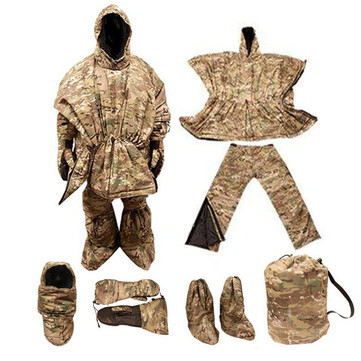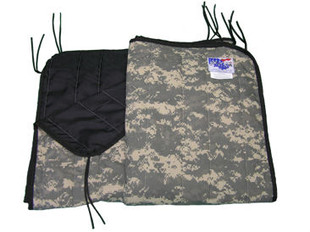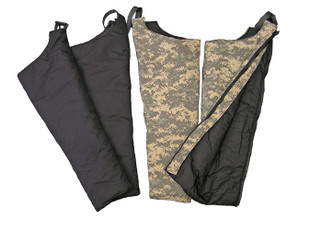 Loading... Please wait...
Loading... Please wait...- Contact
- wiggys@wiggys.com
- Home
- More Products
- Survival Gear
- Survival Kit Items for U.S. Air Force
Wiggy's
Survival Kit Items for U.S. Air Force
Product Description
The kit as a whole consists of six components:
- A poncho that can be worn or converted to a sleeping bag
- A pant that closes on each side with hook and loop
- An insulated head cover
- Boot covers that go to the knee
- Mittens that go above the elbow
- A carry bag to hold all of the components
All of the components are insulated with our 6 oz. Lamilite which is used in our over bags and sweaters. The exterior fabric is nylon with the Multicam camouflage pattern. Like all of the Wiggy products these items are guaranteed never to lose their loft. The reason the Air Force choses Lamilite is because for over 20 years they have never had a Lamilite product go flat after breaking it out of the blister packing.
Sometime back probably about 1992 or so I started working with the U.S. Air Force on vacuum packed survival sleeping bags that were to be placed in fighter jets located in the Alaskan command. The way it worked was they would try several bags in the field (that is the survival instructors). Once they had a bag that performed for them, we vacuum packed it. Initially, they told me the vacuum packed size I had to meet. I told them that was like putting the horse behind the cart. I said let us get a bag that works and then see the size. Fortunately, I prevailed; of course, they had no choice. Until me they were buying down bags that never worked for the temperatures, they needed the bags to perform at, and of course once vacuum packed, they lost immediately about 20 percent of their ability to re-loft and over time they lost all ability to re-loft, whereas the Lamilite NEVER loses its ability to re-loft. As a result of my efforts and the performance capability of the Lamilite, I became their sole source of supply.
In the late nineties the survival instructors from Elmendorf AFB again came to me for a snow suit that could convert to a sleeping bag. This product was vacuum packed as part of the survival kit issued to all personnel that were flying on transports. This was an easy product for me to make since I had made it years before.
In April of 2010 one of the survival instructors that I had worked with on these projects in Alaska who had retired was now hired by the Air Force to develop a new survival system for the B-52 aircraft. He told me it had not been updated since the inception of the aircraft being put into service 60 years ago. To make a long story short, I worked on the project for two years and when we finished, we had a system that worked. He had the survival instructors located at Elmendorf test these items for two winters. What the temperatures actually were I never asked. However, it is Alaska so we know it was cold, and I suspect -20º or lower. You see, these survival instructors take the pilots into the field and train them in winter survival and how to use all of the items that are placed in the survival kit that will be with them if they ever have to eject. The survival instructors take their job very seriously because the life of each and every pilot is far more valuable than the aircraft. When I had General Chuck Yeager visit and tour Wiggy’s he emphasized that point about the pilot being more valuable than the aircraft in no uncertain terms. In any event, the vacuum packed configuration is two pouches which you can see on the web site the way it fits in the ejection seat as well as all of the components.
So, if you are interested in what I believe is the best possible bug out bag or survival bag combination here it is. One of the things I have enjoyed about working with the Air Force on these projects is that they do not use machines like the copper manikin that the Marines or Army uses, they use real live people. And it is from real live people that you get the best feedback.
Product Testimonials
-
'Survival' Garment Pack
April 2024- I just received this garment pack. It IS perfect for storing in the back of my vehicle, in case of a winter driving breakdown in the mountains. But I am currently taking it down to hike in Tierra del Fuego (in late Fall). The multicam is my favorite camo pattern- not too aggressive, passably civilian. The lamilite booties can actually line rubber rain boots, pac boots for snow, or fit into sandals when it is dry out. The pants use side zips to seal the wind out or vent excess body heat, the poncho using velcro (by which it can refold as a sleeping bag). When not worn, the headcover and mitts, like the other pieces, can be easily carried on one's back in the strapped stow bag.
– Harry




